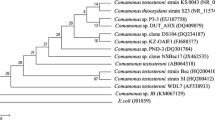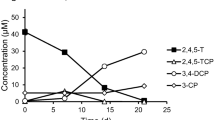Abstract
Mixed cultures degrading chlorinated benzenes, chlorinated phenols, or hexachlorocyclohexane (HCH) as the sole source of carbon and energy were obtained by enrichment from contaminated soil samples. Cultures which metabolized 3-chlorophenol (3-CP), 2,3-dichlorophenol (2,3-DCP), or 2,6-dichlorophenol (2,6-DCP) were able to utilize several other chlorinated compounds as substrates, whereas cultures enriched with 1,2,4,5-tetrachlorobenzene (1,2,4,5-TeCB), α-HCH, or γ-HCH did not metabolize most of the other chlorinated congeners tested. Chloride release and growth rates with all four chlorinated phenols decreased with increasing initial substrate concentrations within the range of 30–250 μmol liter−1. Maximum chloride release was 3.8 mg liter−1 corresponding to 35 μmol liter−1 trichlorophenol within 7 weeks. In contrast, the rate of metabolism of the nonphenolic compounds 1,2,4,5-TeCB, α-HCH, or γ-HCH increased with increasing substrate concentrations. Initial concentrations of 750 μmol liter−1 α-HCH or 1,2,4,5-TeCB were completely dechlorinated within 2 weeks. Because aqueous solubility and bioavailability of the chlorophenolic compounds is much higher than that of the nonphenolic compounds, it is suggested that the high bioavailability of the chlorophenolic compounds is the reason for the high toxicity of these substrates to the degrading cultures. In contrast, the low aqueous solubilities of the chlorinated benzenes and HCH-isomers caused consistently low concentrations in the medium, which were high enough to induce degradation but too low to damage the bacterial cells.
Similar content being viewed by others
References
Apalajahti, JHA, Salkinoja-Salonen MS (1986) Degradation of polychlorinated phenols by Rhodococcus chlorophenolicus. Appl Microbiol Biotechnol 25:62–67
Bachmann A, de Briun W, Jumelet JC, Rijnaarts HNN, Zehnder AJ (1988) Aerobic biomineralization of alpha-hexachlorocyclohexane in contaminated soil. Appl Environ Microbiol 54:548–554
Bachmann A, Walet P, Wijnen P, de Bruin W, Huntjens JLM, Roelofse (1988) Biodgradation of alpha- and beta-hexachlorocyclohexane in a soil slurry under different redox conditions. Appl Environ Microbiol 54:143–149
Balajee S, Mahadevan A (1990) Utilization of chloroaromatic substances by Azotobacter chroococcum. Syst Appl Microbiol 13:194–198
Beltrame P, Beltrame PL, Carniti P (1984) Inhibiting action of chloro- and nitro-phenols on biodegradation of phenol: a structure-toxicity relationship. Chemosphere 13:3–9
Blackburn JW (1987) Prediction of organic chemical fates in biological treatment systems. Environ Progress 6:217–223
Brunner W, Staub D, Leisinger T (1980) Bacterial degradation of dichloromethane. Appl Environ Microbiol 40:950–958
Chu J, Kirsch EJ (1973) Utilization of halophenols by a pentachlorophenol metabolizing bacterium. Dev Ind Microbiol 14:264–273
Crawford RL, Mohn WW (1985) Microbiological removal of pentachlorphenol from soil using a Flavobacterium. Enzyme Microb Technol 7:617–620
de Bont JAM, Vorage MJAW, Hartmans S, van den Tweel WJ (1986) Microbial degradation of 1,3-dichlorobenzene. Appl Environ Microbiol 52:677–680
Fritz H, Reineke W, Schmidt E (1992) Toxicity of chlorobenzene on Pseudomonas sp. strain RHO1, a chlorobenzene-degrading strain. Biodegradation 2:165–170
Goldstein RB, Mallory LM, Alexander M (1985) Reasons for possible failure of inoculation to enhance biodegradation. Appl Environ Microbiol 50:977–983
Haider K, Jagnow G, Kohnen R, Lim SU (1974) Abbau chlorierter Benzole, Phenole and Cyclohexan-Derivate durch Benzol and Phenol verwertende Bodenbakterien unter aeroben Bedingungen. Arch Microbiol 96:183–200
Kiyohara H, Hatta T, Ogawa Y, Kakuda T, Yokoyama H, Takizawa N (1992) Isolation of Pseudomonas pickettii strains that degrade 2,4,6-trichlorophenol and their dechlorination of chlorophenols. Appl Environ Microbiol 58:1276–1283
Knackmuss H-J, Hellwig M (1978) Utilization and cooxidation of chlorinated phenols by Pseudomonas sp. B 13. Arch Microbiol 117:1–7
Lang E, Viedt H, Egestorff J Hanert HH (1992) Reaction of the soil microflora after contamination with chlorinated aromatic compounds and HCH. FEMS Micr Ecol 86:275–282
Li DY, Eberspächer J, Wagner B, Kuntzer J, Lingens F (1991) Degradation of 2,4,6-trichlorophenol by Azotobacter sp. GPI. Appl Environ Microbiol 57:1920–1928
Liu D, Thomson K, Kaiser KLE (1982) Quantitative structure-toxicity relationship of halogenated phenols on bacteria. Bull Environ Contam Toxicol 29:130–136
Marinucchi AC, Bartha R (1979) Biodegradation of 1,2,3- and 1,2,4-trichlorobenzene in soil and in liquid enrichment culture. Appl Environ Microbiol 38:811–817
McCarthy JF, Zachara JM (1989) Subsurface transport of contaminants. Environ Sci Technol 23:496–502
Menke B, Rehm HJ (1992) Degradation of mixtures of monochlorophenols and phenol as substrates for free and immobilized cells of Alcaligenes sp. A7–2. Appl Microbiol Biotechnol 37:655–661
Neilson AH (1990) The biodegradation of halogenated organic compounds. J Appl Bacteriol 69:445–470
Reineke W, Knackmuss HJ (1984) Microbial metabolism of haloaromatics: isolation and properties of a chlorobenzene-degrading bacterium. Appl Environ Microbiol 47:395–402
Rochkind-Dubinsky ML, Sayler GS, Blackburn JW (1987) Microbiological decomposition of chlorinated aromatic compounds. Marcel Dekker, Inc., New York
Sahu SK, Patnaik KK, Sharmila M, Sethunathan N (1990) Degradation of alpha-, beta-, and gamma-hexachlorocyclohexane by a soil bacterium under aerobic conditions. Appl Environ Microbiol 56:3620–3622
Sander P, Wittich RM, Fortnagel P, Wilkes H, Francke W (1991) Degradation of 1,2,4-trichlorobenzene and 1,2,4,5-tetrachlorobenzene by Pseudomonas strains. Appl Environ Microbiol 57:1430–1440
Schraa G, Boone ML, Jetten MSM van Neerven ARW, Colberg P (1986) Degradation of 1,4-dichlorobenzene by Alcaligenes sp. strain A175. Appl Environ Microbiol 52:1374–1381
Schwarzenbach RP, Giger W, Hoehn E, Schneider JK (1983) Behaviour of organic compounds during infiltration of river water to groundwater. Field studies. Environ Sci Technol 17:472–479
Shimp RJ, Pfaender FK (1987) Effect of adaptation to phenol on biodegradation of monosubstituted phenols by aquatic microbial communities. Appl Environ Microbiol 53:1496–1499
Stanlake GJ, Finn RK (1982) Isolation and characterization of a pentachlorophenol-degrading bacterium. Appl Environ Microbiol 44:1421–1427
vander Meer JR, Roelofsen W, Schraa G, Zehnder JB (1987) Degradation of low concentrations of dichlorobenzenes and 1,2,4-trichlorobenzene by Pseudomonas sp. strain P51 in nonsterile soil columns. FEMS Micr Ecol 45:333–341
Author information
Authors and Affiliations
Additional information
Correspondence to: E. Lang
Rights and permissions
About this article
Cite this article
Lang, E., Viedt, H. Degradation by and toxicity to bacteria of chlorinated phenols and benzenes, and hexachlorocyclohexane isomers. Microb Ecol 28, 53–65 (1994). https://doi.org/10.1007/BF00170247
Received:
Revised:
Issue Date:
DOI: https://doi.org/10.1007/BF00170247




